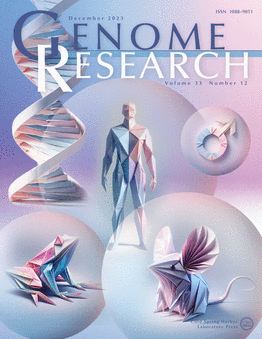利用捕获的STARR-seq技术绘制人类原代神经祖细胞的增强子区域图
IF 5.5
2区 生物学
Q1 BIOCHEMISTRY & MOLECULAR BIOLOGY
引用次数: 0
摘要
全基因组关联研究(GWASs)和表达分析暗示非编码调控区域是精神疾病的危险因素,但这些区域的功能表征仍然有限。在这里,我们对超过70,000个候选区域进行了捕获starr测序,以鉴定初级人类神经祖细胞(phnpc)中的活性增强子。我们通过整合npc、前额皮质、发育时间点和GWASs的数据来选择候选区域。超过8000个区域在phNPCs中显示增强子活性,我们将这些区域与2200多个预测的靶基因联系起来。这些基因参与神经和精神疾病相关通路,包括神经系统、神经系统发育和发育迟缓。我们使用突变starr测序和CRISPR缺失对这些增强子的一个子集进行了功能验证,证明了遗传变异对增强子活性和增强子缺失对基因表达的影响。总的来说,我们确定了数千种高度活跃的增强子,并对这些增强子的一个子集进行了功能验证,从而提高了我们对脑功能和疾病背后的调节网络的理解。本文章由计算机程序翻译,如有差异,请以英文原文为准。
A map of enhancer regions in primary human neural progenitor cells using capture STARR-seq
Genome-wide association studies (GWASs) and expression analyses implicate noncoding regulatory regions as harboring risk factors for psychiatric disease, but functional characterization of these regions remains limited. Here, we perform capture STARR-sequencing of over 70,000 candidate regions to identify active enhancers in primary human neural progenitor cells (phNPCs). We select candidate regions by integrating data from NPCs, prefrontal cortex, developmental timepoints, and GWASs. Over 8000 regions demonstrate enhancer activity in the phNPCs, and we link these regions to over 2200 predicted target genes. These genes are involved in neuronal and psychiatric disease-associated pathways, including neuronal system, nervous system development, and developmental delay. We functionally validate a subset of these enhancers using mutation STARR-sequencing and CRISPR deletions, demonstrating the effects of genetic variation on enhancer activity and enhancer deletion on gene expression. Overall, we identify thousands of highly active enhancers and functionally validated a subset of these enhancers, improving our understanding of regulatory networks underlying brain function and disease.
求助全文
通过发布文献求助,成功后即可免费获取论文全文。
去求助
来源期刊

Genome research
生物-生化与分子生物学
CiteScore
12.40
自引率
1.40%
发文量
140
审稿时长
6 months
期刊介绍:
Launched in 1995, Genome Research is an international, continuously published, peer-reviewed journal that focuses on research that provides novel insights into the genome biology of all organisms, including advances in genomic medicine.
Among the topics considered by the journal are genome structure and function, comparative genomics, molecular evolution, genome-scale quantitative and population genetics, proteomics, epigenomics, and systems biology. The journal also features exciting gene discoveries and reports of cutting-edge computational biology and high-throughput methodologies.
New data in these areas are published as research papers, or methods and resource reports that provide novel information on technologies or tools that will be of interest to a broad readership. Complete data sets are presented electronically on the journal''s web site where appropriate. The journal also provides Reviews, Perspectives, and Insight/Outlook articles, which present commentary on the latest advances published both here and elsewhere, placing such progress in its broader biological context.
 求助内容:
求助内容: 应助结果提醒方式:
应助结果提醒方式:


